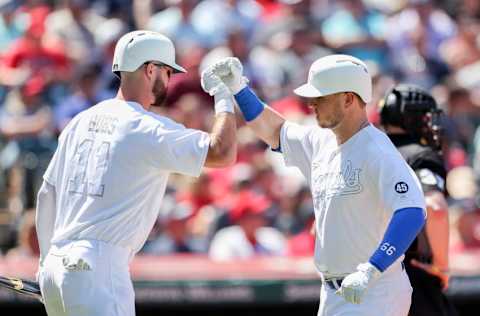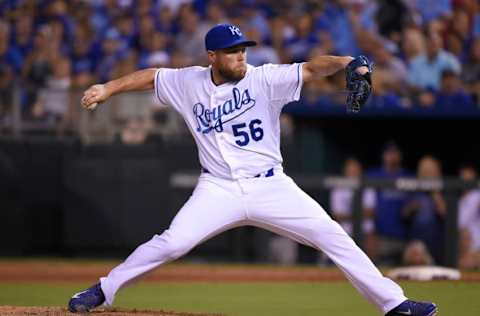KC Royals: Momentum shifts could hurt these 3 players


Three KC Royals were playing well when spring training came to a halt. Now, shifts in momentum could jeopardize their chances to make the club when baseball returns.
For three KC Royals with much at stake, the suspension of baseball came when momentum was with them. Former Royal closer Greg Holland was vying to re-establish his career where it started and peaked, Ryan O’Hearn was battling to retain his starting first base job and Bubba Starling was just fighting to stay in The Show. Good spring training performances helped, but they’ll need to maintain their good Cactus League momentum.
Momentum, however, is a fickle thing, a volatile sports force capable of creating or destroying hot streaks and bringing even the best athletes to their knees. A shift in their personal “Big Mo” when baseball returns may spell trouble for Holland, O’Hearn and Starling.
And for better or worse, spring training breeds momentum shifts. It’s a period of experimentation and preparation when veteran pitchers tinker with mechanics and new pitches; hitters work to recapture and refine timing while so often facing young, unproven hurlers who know more about throwing than pitching. Spring training skews statistics–weak or inconsistent hitters thrive on the many minor league pitchers they confront and experienced pitchers dominate batters searching for their timing.
Simply put, spring training-generated momentum inflates statistics beyond regular season norms and the regular season exposes the false promises of those spring camp numbers. Compare, for example, the stellar 2019 spring stats of O’Hearn and Starling with their subsequent regular season numbers.
O’Hearn had a homer with 14 RBIs and hit .320 in 50 at-bats, then plummeted to .195 (70 OPS+) and 14 homers and 38 RBIs for the season; Starling hit two spring homers with six RBIs and hit .344 with a 1.057 OPS+, then nose-dived to .215 with a 50 OPS+ in 56 games.
Should further proof of spring training momentum gone bad be required, consider the depressing case of Chris Owings, who tore up 2019 Cactus League pitching with four home runs, 13 RBIs, a .333 average and 1.129 OPS+ in 51 at-bats; when the real season came, his .133 in 40 games triggered his release and he then hit .156 in 26 games for Boston.
Such negative momentum swings will only hurt Holland, O’Hearn and Starling.

A momentum shift could cost former KC Royals closer Greg Holland a roster spot with his old team.
A career coming full circle seemed within Greg Holland’s grasp when March 12 dawned on the KC Royals’ Arizona spring training base. He’d pitched for the sixth time three days before, giving up a walk and striking out one in a hitless one-inning appearance. For Holland, the brief stint marked a course correction after two bumpy appearances and appeared to reinforce his chances to return to the Royals’ bullpen.
Holland was the Royals’ no-nonsense closer from 2013 until late 2015, saving 125 games and anchoring the feared H-D-H bullpen triumvirate (Kelvin Herrera and Wade Davis were the other components) until he gave in to a torn UCL that cut short his ’15 season. The Royals didn’t re-sign him and he next pitched for Colorado in 2017. He made the NL All-Star team, saved 41 games and averaged 11 strikeouts per nine innings. Only his 3.61 ERA suggested he’d lost something–3.83 in his injury-plagued 2015 was by far the highest he’d posted with KC.
But Holland had indeed lost something–he signed with St. Louis for 2018, but was released in August after going 0-2 with a 7.92 ERA with 22 walks and 34 hits in 25 innings. He caught on with Washington for the rest of the campaign and posted a 2-0 record, 0.84 ERA and 25 strikeouts in 21.1 innings. But he crashed last season with Arizona–his 4.52 ERA, 6.1 BB9 and a series of blown saves led to another August release; he re-signed with the Nationals but only pitched in the minors.
Holland began the postseason as a minor league free agent; speculation that he might come home to Kansas City ended when he signed a minor league contract with the Royals and received a non-roster invitation to spring camp.
Holland pitched like the man on a mission that he was, striking out four and holding opponents scoreless through his first three one-inning stints. But he gave up a homer in his fourth game, then three hits (including another homer) and two runs in his fifth to push his ERA to 5.40. It was easy to wonder if Holland’s quest to make the club was unraveling.
He returned to form, though, in his next outing, that scoreless inning he threw March 9. March 12 would probably have been his next day to pitch, but instead became the day baseball stopped, and with it Holland’s journey back to Kansas City.
Once baseball starts up again, Holland’s margin for error will be slim. Save for his two shaky games, Holland was, to be sure, pitching well. But at age 34, he’s at a point where shakiness means more and is tolerated less. Momentum favored him for three games, then shifted just enough to call his comeback into question; whether his last game stabilized Holland remains to be seen and won’t be known until baseball resumes.
For Holland, momentum now means everything.

Ryan O’Hearn won the KC Royals’ first base job with a good 2018 season, but a 2019 downturn put the position back in play. If spring momentum shifts away from him, he may be headed to the bench.
From his first days in the minor leagues, his power alone suggested Ryan O’Hearn would make it to the majors. Beginning with a partial Rookie ball season after he signed with the KC Royals in 2014 and progressing through his partial Triple-A season in 2018, O’Hearn hit 13, 27, 22, 22 and 11 home runs to average almost 20 per campaign. That consistent power propelled him to the majors midway through 2018.
O’Hearn played well and stepped into the first base job left woefully vacant by Eric Hosmer. His 12 home runs, 30 RBIs and .262 average in 44 games were sufficient to earn the job for 2019.
What was to be his first full big league season became all but a disaster for O’Hearn–he did manage 14 homers, but weak hitting forced the Royals to demote him to Omaha; although he seemed to recover his stroke there and returned to KC, he ended the season at .195 with a dismal 70 OPS+.
That O’Hearn’s offensive decline revived concerns about first base became settled when the Royals purchased first baseman-outfielder Ryan McBroom from the Yankees in late August. McBroom hit .293 in 23 games for KC; O’Hearn hit four homers and batted .250 the rest of the way to further muddle the picture.
The March 12 suspension of baseball likely left the inevitable O’Hearn vs. McBroom spring training competition for first base unresolved–O’Hearn’s five home runs were better by two than McBroom’s homers, O’Hearn had one more RBI, and O’Hearn hit .343 to McBroom’s .314, a misleading margin considering each had the same number of at-bats and McBroom had only one less hit than O’Hearn.
So momentum, which O’Hearn and McBroom both had when games stopped, favors neither. If there’s an edge, it’s probably with O’Hearn considering he’s the incumbent, manager Mike Matheny was impressed with him even before spring training began and McBroom is, as mentioned previously in this space, a lock to make the club as a utility player.
But just because McBroom will make the roster, in any event, doesn’t mean O’Hearn’s first base job is safe. His spring momentum is important and encouraging, but his second-season slump lasted the entire 2019 campaign, a blight that a good but abbreviated spring training won’t remove. If O’Hearn’s momentum changes when the games resume, McBroom will be around.

Momentum shifts are no stranger to Bubba Starling. Now, they may be more critical to him than ever.
Bubba Starling knows momentum. It’s been his friend and enemy throughout an eight-year professional career launched on the promise of the $7.5 million signing bonus he received as the KC Royals’ 2011 first-round draft pick.
Starling agreed to his KC deal just before the August signing deadline, delaying his pro debut until 2012. He started and ended well–.275 with 10 homers and 33 RBIs in 53 games–but Big Mo then paid him an unfriendly and long-lasting visit. For the next six seasons, Starling suffered injuries, his power all but disappeared and, except for his 12-game .386 average at High A Wilmington in 2015, he didn’t eclipse his first season average until hitting .310 in 72 games at Omaha last season. (.500 in eight at-bats at Idaho Falls two seasons ago just doesn’t count).
But, as evidenced by that .310 at Omaha last year, momentum shifted in his favor in 2019. Preceded by an excellent spring training performance, seven homers and 38 RBIs in his 72 games complemented the .310 average; his .448 slugging percentage, .358 OBP and .806 OPS were all second-best career marks for seasons in which he enjoyed significant playing time. Impressed, the KC Royals called him up in July for his first taste of the big leagues.
But momentum shifted against him once again and he finished the season with a .215/.253/.317 slash and troubling 50 OPS+ in 56 games. His four home runs and 12 RBIs were disappointing.
The fact Starling won’t be competing for a starting job this season (the outfield is set with Alex Gordon, Whit Merrifield and Hunter Dozier) didn’t get in the way of a good spring. Through 30 at-bats when play ceased, Starling was slashing .367/.441/.767 with a superb 1.208 OPS+ and three home runs.
By now, though, Starling knows all too well how volatile momentum can be. His great 2019 Cactus League numbers (.344/.432/.625, 1.057 OPS+) and fine Omaha stats meant little when he reached the big leagues and momentum became unfriendly.
Starling is out of minor league options and a handful of young outfielders on the verge of their major league debuts nip at his heels, making 2020 a crossroads season for him. No one knows when baseball will return but when it does, Starling probably can’t afford to lose the momentum of this spring.
Next. Trevor Rosenthal project looks good. dark
Momentum is sometimes a friend, sometimes a foe. KC Royals Greg Holland, Ryan O’Hearn and Bubba Starling need it to be their friend when baseball returns.